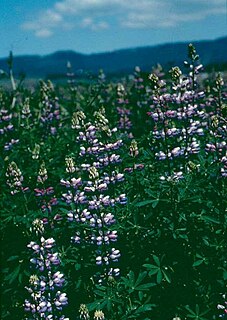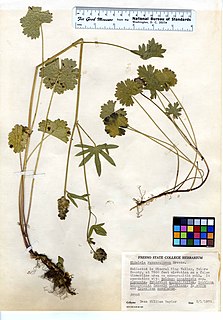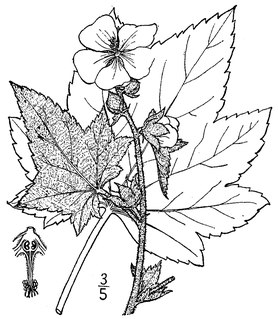
Delphinium bakeri, or Baker's larkspur, is a species of perennial herb in the buttercup family, Ranunculaceae. It is endemic to California in the United States, where it is a federally listed endangered species. It is known in the wild from one remaining occurrence near Salmon Creek in Sonoma County, where only seven plants remained as of March 2006.

Cupressus bakeri, reclassified as Hesperocyparis bakeri, with the common names Baker cypress, Modoc cypress, or Siskiyou cypress, is a rare species of cypress tree endemic to a small area across far northern California and extreme southwestern Oregon, in the western United States.

Salix lasiolepis is a species of willow native to western North America.

Iliamna is a small genus of flowering plants in the mallow family, endemic to North America. It is related to the bush mallows of California (Malacothamnus) and to Phymosia of Mexico, Central America and the Caribbean. These perennial herbs are known commonly as wild hollyhocks and sometimes as globe mallows, Kankakee mallow, Kankakee globe mallow, and Streambank wild hollyhock. More often, the latter terms refer to members of the genus Sphaeralcea, which belong, like Iliamna, to the "typical" mallow tribe (Malveae) of the mallow and hibiscus subfamily Malvoideae. The name of the genus, proposed by Edward Lee Greene, appears to be a reference to Iliamna Lake in Alaska, even though the genus Iliamna does not occur in Alaska

Iliamna rivularis, known by the common name streambank wild hollyhock, is a perennial plant species in the family Malvaceae.

Erigeron glaucus is a species of flowering plant in the daisy family known by the common name seaside fleabane, beach aster, or seaside daisy.
Iliamna latibracteata is an uncommon species of flowering plant in the mallow family known by the common names California globe mallow and California wild hollyhock.

Arctostaphylos bakeri is a species of manzanita known by the common name Baker's manzanita. It is endemic to Sonoma County, California, where it grows in the chaparral and woodlands of the North Coast Ranges. It is sometimes a member of the serpentine soils flora.
Crepis bakeri is a species of flowering plant in the daisy family known by the common name Baker's hawksbeard. It is native to the western United States where it grows in many types of mountain and plateau habitat. It is found in Oregon, Washington, Idaho, northern California, Nevada, and Utah.
Hackelia cusickii is a species of flowering plant in the borage family known by the common name Cusick's stickseed.
Lupinus adsurgens is a species of lupine known by the common name Drew's silky lupine. It is native to the Sierra Nevada and coastal mountain ranges of northern California and southern Oregon, where it grows in forest and other mountain habitat. It is a perennial herb growing 20–60 centimetres (7.9–23.6 in) in height. Each palmate leaf is made up of 6 to 9 leaflets each up to 5 centimetres (2.0 in) long. The herbage is hairy and silvery or gray-green in color. The inflorescence is up to 23 centimetres (9.1 in) long, bearing flowers just over a centimeter long. The flower is pale pink or purple to yellowish with a white or yellow patch on the banner. The fruit is a silky-haired legume pod 2 to 4 centimetres (1.6 in) long containing 3 to 6 seeds.

Lupinus albicaulis is a species of lupine known by the common name sicklekeel lupine. It is native to the western United States from Washington to California, where it grows mostly in mountain habitat. It is a hairy, erect perennial herb often exceeding a meter in height. Each palmate leaf is made up of 5 to 10 leaflets each up to 7 centimetres long. The inflorescence is up to 44 centimetres (17 in) long, bearing whorls of flowers each 1 to 1.6 centimetres long. The flower is purple to yellowish or whitish in color and has a sickle-shaped keel. The fruit is a silky-hairy legume pod up to 5 centimetres (2 in) long containing several seeds. In Oregon, where the plant is native, it has been cultivated for several uses, including reforestation and revegetation of roadsides and other disturbed habitat.

Malvella leprosa is a species of flowering plant in the mallow family known by the common names alkali mallow and alkali sida. It is native to much of the western United States, Mexico, Argentina, and Chile. It is known in parts of Australia as an introduced species. In many regions, whether native there or not, the plant is often a noxious weed and easily invades habitat, including areas with alkaline and saline soils. In California, the plant can be found in agricultural lands, including fields and orchards. This is a decumbent perennial herb producing a white-hairy stem up to about 40 centimetres (16 in) long, spreading along the ground. The leaves are variable in shape but are generally lobed and wavy along the edges, measuring 1 to 3 centimetres wide. Leaves appear in the leaf axils singly or in clusters of up to 3. Each flower is a cup-shaped corolla of five petals up to 1.5 centimetres long in shades of pale pink, white, or light yellow. The disc-shaped fruit is divided into several segments.
Pedicularis howellii is an uncommon species of flowering plant in the family Orobanchaceae known by the common name Howell's lousewort. It is endemic to the Siskiyou Mountains of the Klamath Range in southern Oregon and northern California, where it grows on the edges of coniferous forests. This is a perennial herb producing one or more stems up to 45 centimetres (18 in) tall from a long caudex. The leaves are up to 20 centimetres (8 in) long, lance-shaped, and divided into many toothed oval lobes; those higher on the stem may be unlobed. The basal leaves fall away early. The inflorescence is a small raceme of flowers occupying the top of the stem. Each white to light purple flower is up to one centimetre long and is sickle-shaped, with a curved beak-like upper lip and a three-lobed lower lip which may be tucked into the hairy mass of sepals. The plant is pollinated by bumblebees including Bombus mixtus. Between the flowers are hairy to woolly triangular bracts. The fruit is a capsule just under a centimeter long containing seeds with netted surfaces.

Sidalcea calycosa is a species of flowering plant in the mallow family known by the common names annual checkerbloom, checker mallow, and vernal pool checkerbloom.

Sidalcea glaucescens is a species of flowering plant in the mallow family known by the common name waxy checkerbloom.

Sidalcea ranunculacea is a species of flowering plant in the mallow family known by the common name marsh checkerbloom and marsh checker mallow.
Trichostema simulatum is a species of flowering plant in the mint family known by the common name Siskiyou bluecurls.

Viola bakeri is a species of violet known by the common name Baker's violet. It is native to the Western United States, from Washington and Oregon, to the mountains of northern Nevada, and in California to the southern High Sierra Nevada.

Iliamna remota, commonly known as the Kankakee mallow, is an endangered species of flowering plant in the mallow family. It is endemic to a single location, the 700-metre-long (2,300 ft) Langham Island in Kankakee River State Park, in the US state of Illinois.














